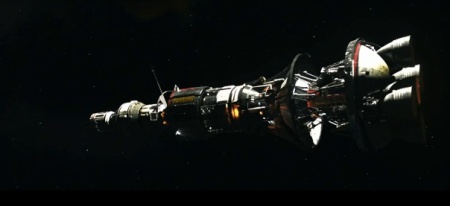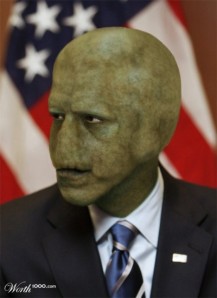 WARNING: Post contains spoilers for those who have not seen the finale! Read at your own risk!
WARNING: Post contains spoilers for those who have not seen the finale! Read at your own risk!
Who would have though Ron Moore was a religious guy? Even in a non-denominational, non-single religion way?
The finale brought us quality CGI battle scenes, lots of ammo spent, a couple of standoffs, murder and suicide, some tearful moments (for me, not just the characters), and, for the show, a pretty happy ending. It also left some questions about The Bigger Things: Head Six and Head Baltar are angels? Sort of, anyway. And what was Starbuck?
Moore sheds a little light on it in the interview you can read here. The last hour felt odd to me, because once again the planet had a definite visual feel to it. Old Caprica was pretty much shot normally, with no color alterations. New Caprica was shot to look very washed-out all the time. Real Earth (Earth #1?) was blue-gray; a visual cinder. New Earth’s colors were oversaturated, and I swear some of the clouds were CGI to make it look even more pristine than normal. Maybe that was all done to convince us that British Columbia looks like prehistoric Tanzania. I think it was definite decision to make it feel brighter, happier, and filled with promise.
Thanks, Ron, for not ending the series any darker. We needed to “play them out with music at the end,” as Heinlein would say. The fact that they would all soon be scratching out a menial existence was enough.

I want to make sure we remember J. Michael Strazynski and Babylon 5 at this moment. Without B5 and its groundbreaking use of story arc we could never have had BSG. (By the way, the original B5 Lurker’s Guide is still up, thank the Great Maker.) I know, other shows have done story arcs, but four years? Lost, maybe. It’s still a tough sell to a network, I’m sure. But B5 was where TV science fiction grew up, and storytelling because more than the monster-of-the-week.
Ron Moore tried to make BSG relevant to the questions of our day, as did Gene Roddenberry in his original vision of Star Trek. In large part, he succeeded. He knew that the majority of his audience was going to be held by the character development. He apparently had no concerns that the audience would be unable to suspend their disbelief about the underpinnings of the show, such as what makes a Cylon a Cylon. As far as we could see, they were human. One, because of God’s Love, was even able to have a child with a human. Where’s the machinery? Moore always tried to avoid the nerdiness factor that could have doomed the show…but I guess I’m that nerd, because I’d like a little more reason to believe Cylons were at least partly non-human. Maybe “The Plan,” the prequel movie Edward James Olmos directed and which will air next fall, will tell us. But I doubt it. I would expect it was written more to bridge to the prequel series, “Caprica.” Maybe we will learn more there.
 And what ever happened to the Centurions? Are they still out there? Did they build a machine civilization? Are they V’ger? Are they the Borg? I hope not. I expect something better of our favorite toasters!
And what ever happened to the Centurions? Are they still out there? Did they build a machine civilization? Are they V’ger? Are they the Borg? I hope not. I expect something better of our favorite toasters!
EDIT, supplemental:
Here is a link to Maureen Ryan’s interview with Ron Moore and her thoughts on the finale from the Chicago Tribune: link
She caused me to remember a couple of other points:
First, JMS was (and is, I supposed) an avowed atheist. In fact, he used to work for Madelyne Murray O’Hair’s atheist magazine. His picture of the universe included “Old Ones,” beings who apparently moved to the End of the Universe after they tired of reality and playing the game. He also made the mysterious alien Kosh as the kind of being humans had interpreted as angels, and the Shadows as demons, or at least as the creatures who kindled such mythology. He resurrected his main character without telling much about how. He was willing to say there were things We Could Not Yet Understand, but he didn’t make them completely unknowable…just that we weren’t there yet. It was a sort of an explanation of the bases of man’s religions that traded some scientific Mysteries for spiritual ones. Was that really a trade? JMS left that open-ended. There were many religious references and discussions within the show. To JMS’ credit, he always treated them with great respect. I always thought of him as more of an agnostic…the show seemed on one level to be JMS trying to work out what was to him a reasonable belief system.
 Ron Moore, as you can see from the two interviews referenced above, was not that subtle. Some Things We Cannot Know, and may never know…at least on this side of reality. (Anders to the departing Kara Thrace: “See you on the other side.”) I never made a connection of a sort of Holy Trinity about the show, but in a way it was very true. Kara was very much a Holy Spirit at the end. I think Moore’s characters are in some way more aware of their importance to the human race, because there is so little of it left, and very unaware of their lasting influence. They are just trying to survive and do the right thing, with little time for reflecting on the big picture…unless they end the reflection pretty much roaring drunk.
Ron Moore, as you can see from the two interviews referenced above, was not that subtle. Some Things We Cannot Know, and may never know…at least on this side of reality. (Anders to the departing Kara Thrace: “See you on the other side.”) I never made a connection of a sort of Holy Trinity about the show, but in a way it was very true. Kara was very much a Holy Spirit at the end. I think Moore’s characters are in some way more aware of their importance to the human race, because there is so little of it left, and very unaware of their lasting influence. They are just trying to survive and do the right thing, with little time for reflecting on the big picture…unless they end the reflection pretty much roaring drunk.
The main characters JMS established in B5 were aware of their importance – world leader, emissary, religious icon, leader of all sapient creatures (!). They often acted accordingly. And yet the show was about the characters, just as BSG was. G’Kar was my favorite on B5, and I just realized there are parallels with my favorite BSG character…Starbuck. Hmm. Maybe these two series aren’t as different as I first thought…



















 While I was looking around on the
While I was looking around on the  WARNING: Post contains spoilers for those who have not seen the finale! Read at your own risk!
WARNING: Post contains spoilers for those who have not seen the finale! Read at your own risk!
 And what ever happened to the Centurions? Are they still out there? Did they build a machine civilization? Are they V’ger? Are they the Borg? I hope not. I expect something better of our favorite toasters!
And what ever happened to the Centurions? Are they still out there? Did they build a machine civilization? Are they V’ger? Are they the Borg? I hope not. I expect something better of our favorite toasters! Ron Moore, as you can see from the two interviews referenced above, was not that subtle. Some Things We Cannot Know, and may never know…at least on this side of reality. (Anders to the departing Kara Thrace: “See you on the other side.”) I never made a connection of a sort of Holy Trinity about the show, but in a way it was very true. Kara was very much a Holy Spirit at the end. I think Moore’s characters are in some way more aware of their importance to the human race, because there is so little of it left, and very unaware of their lasting influence. They are just trying to survive and do the right thing, with little time for reflecting on the big picture…unless they end the reflection pretty much roaring drunk.
Ron Moore, as you can see from the two interviews referenced above, was not that subtle. Some Things We Cannot Know, and may never know…at least on this side of reality. (Anders to the departing Kara Thrace: “See you on the other side.”) I never made a connection of a sort of Holy Trinity about the show, but in a way it was very true. Kara was very much a Holy Spirit at the end. I think Moore’s characters are in some way more aware of their importance to the human race, because there is so little of it left, and very unaware of their lasting influence. They are just trying to survive and do the right thing, with little time for reflecting on the big picture…unless they end the reflection pretty much roaring drunk.